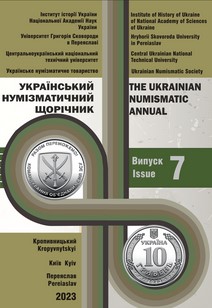РАНІШЕ НЕВІДОМИЙ НАПІВДИРХАМ М.Д. МУХАММАДІЯ 183 Р. Х. (799/800 Р.Н.Е.) – ПІДТВЕРДЖЕННЯ КАРБУВАННЯ ФРАКЦІЙНИХ НОМІНАЛІВ СРІБНИХ МОНЕТ У РАННЬОМУ АББАСИДСЬКОМУ ХАЛІФАТІ
AN UNKNOWN 183AH (799/800 AD) MUHAMMADIA MINT HALF-DIRHAM – THE CONFIRMATION OF THE FRACTIONAL COIN PRODUCE IN THE EARLY ABBASID CALIPHATE
Author(s): Yevhen LembergSubject(s): Archaeology, Economic history, 6th to 12th Centuries
Published by: ДВНЗ Переяслав-Хмельницький державний педагогічний університет імені Григорія Сковороди
Keywords: Abbasid Caliphate; fractional dirham denominations; Muhammadiya mint; estimation of original area and weight of damaged coins; coins from numismatic auctions;
Summary/Abstract: In this study, we explore the issuance of fractional silver denominations during the formative phase of the Abbasid Caliphate (mid-8th to early 9th century CE), focusing on a previously unrecognized half-dirham minted in AH 183 (799/800 CE) in Muhammadiya. The objective is to propose a probable attribution for this coin, suggesting its origination from the Muhammadiya mint in the Armenian province, alternatively known as Ma'dan Bajunays. This analysis contributes to the ongoing scholarly discourse regarding the uniformity versus regional variability in the coinage standards of the Abbasid era. Conclusions: The investigation into fractional dirhams extends to a broader examination of the dirham concept, delineating it as a monetary unit with specific mass and weight parameters. Utilizing mathematical modeling and advanced graphic editing tools, we reconstruct the original dimensions and mass of the coin, aligning with the value of a nisf (half-dirham). This research also encompasses a comparative study of fractional coinage from the mints of Muhammadiya, Arran, Ma‗dan Bajunays, and Tabaristan. New findings, surfaced through international numismatic auctions, allow for an in-depth analysis of fractional dirhams' quality, imagery, and metrics. The study further delves into examples of coins displaying imitative minting patterns, primarily based on the half-dirham. The examination extends to suberat coins, ostensibly crafted by counterfeiters, impacting the currency circulation adversely. To distinguish the Muhammadiya mint's coins from those of contemporaneous mints potentially sharing its nomenclature, the study introduces additional evidence and reasoning, affirming the association of the described coins explicitly with the Muhammadiya II mint, linked to the Bajunays silver mine. The scarcity of such coinage highlights the limited nature of these issuances and underscores their role in addressing local demands within regions like Arminiya and facilitating trade with the northern neighbors of the caliphate. The methodology employed for the assessment of the coins' original weight, particularly those exhibiting wear and tear, is meticulously detailed, demonstrating a novel approach to historical numismatic analysis. In concluding, the study posits a potential correlation between these emissions and the "rezanas" discovered within Ukrainian territory – fragmented Kufic dirhams that were prevalent in circulation, further enriching our understanding of the Abbasid monetary system's complexity and reach.
Journal: Український Нумізматичний Щорічник
- Issue Year: 2023
- Issue No: 7
- Page Range: 145-160
- Page Count: 16
- Language: Ukrainian

